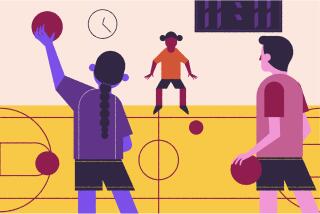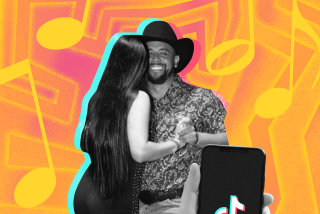Black Dancers Defy Stereotypes : Americana: Dudes & Dames Inc. square dance club of Baldwin Hills marks 25th anniversary. Group was originally told it wouldn’t last a year.
The gathering in the church hall had all the ingredients of an old-fashioned hoedown. The couples wore their best Western duds--string ties, fancy shirts and cowboy boots for the men, full skirts and petticoats for the women.
“Hey little boy and little girl, it’s square dance time,” caller Andy Rawlinson sang out. “Grab your partner and get on the floor.” At Rawlinson’s command they swung into motion--allemande left, circle right, do-si-do and so on.
The scene could have been straight out of the heartland, except for a few details: The location was Crenshaw Methodist Church, the dancers were predominantly black and the caller was sneaking in some lyrics from a Pointer Sisters song.
But defying stereotypes is nothing new for the Dudes & Dames Inc. of Baldwin Hills. The oldest predominantly black square dance group in the state observed its 25th anniversary last month, and about 200 dancers showed up to celebrate.
“Square dancing is America’s national folk dance,” said Carrie Jones, a member of Dudes & Dames for more than 20 years. “Square dancing is wonderful. It’s a family activity, it’s good exercise and it’s a place for social gathering without alcohol.”
In California, there are about 750 square dance clubs and about 75,000 dancers, according to Jim Maczko, president of the California Square Dance Council. The national organization, United Square Dancers of America, has roughly 500,000 members, he said.
Despite its overall popularity, many blacks see square dancing as a Southern tradition rooted in segregation. Indeed, members of Dudes & Dames say they tasted rejection in Los Angeles during the group’s early days.
“We would go to dances and (white dancers) would just refuse to get on the floor with us,” said Frank Jones. “I remember we went to a dance at the Police Academy and they wouldn’t let us in. We would come in with six people and no one would get up and join our square (to make eight).”
Said Helen Proctor, who hosted the group’s first meeting in her living room, “Back when we started 25 years ago, we were told we wouldn’t last a year. I guess they were wrong.”
Over the years, the barriers against blacks participating in square dancing have crumbled.
The Dudes & Dames joined the local square dance association in 1972. They soon gained recognition and were invited to dance before audiences throughout Los Angeles. Frank and Carrie Jones have served as vice presidents of the California Square Dance Council and danced in the Tournament of Roses Parade.
Rawlinson, an early member of the group, has parlayed his hobby into a career. He travels throughout the country and even overseas calling dances. He recently took a group of teen-agers to Romania and Poland to demonstrate square dancing.
“I met my wife, Margie, when she walked into a square dance class I was teaching,” he said. “She walked in, things happened and the rest is history.”
In the beginning, however, Rawlinson said he was a reluctant convert to square dancing.
“I didn’t like the music, he said. “I was turned off by the country and Western sound. And even though I make a living at it, I still don’t like the music just to sit down and listen to it. There’s something about the twang that gets to me. It may sound weird, but I prefer jazz or easy-listening music.”
More to Read
The biggest entertainment stories
Get our big stories about Hollywood, film, television, music, arts, culture and more right in your inbox as soon as they publish.
You may occasionally receive promotional content from the Los Angeles Times.










